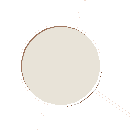
The Thrower's Page
![]() EVENTS
EVENTS
Shot
Discus
Hammer
Javelin
![]() STATS
STATS
Rankings
Age
Combos
Both hands
Other
![]() FACILITIES
FACILITIES
Layout
Sectors
Indoor
Outdoor
Insert
Racks
Overlapping
Repair
![]() INFORMATION
INFORMATION
NEW: Shoes
Paint your disc
Short wires
Physics
Pants
Training
Charting
Youth
High School
College
Wt. pentathlon
![]() OPINION
OPINION
Chip
Handle
Specs
Doping
Measuring
Paint your Disci!
Tony Dziepak, 29Apr03I want to start a revolution--to get everyone to start painting half of their discus in a contrasting color. And if it catches on, soon implement manufacturers and suppliers will start selling disci that are prepainted that way.
How? I mean, paint half of the discus a contrasting color. I mean, laying the discus flat, you see a bright semicircle and a dark semicircle. Here's how: for the standard high school or practice black rubber disks, paint half of the circle white or "football-goalpost/tennis-ball" flourescent yellow.
First thoroughly clean used disci of dirt using warm soapy water and a scrub brush. Rinse, towel dry then air dry for 24 hours. Then cover half the discus (top and bottom) with masking tape and newspaper. Spraypaint the exposed sides.
For plastic/wood discs with metal rims, do the same, except I recommend not painting the metal rim part. Simply cover half the discus as described, above. Then put an extra strip of masking tape along the rim. If the discus is light-colored, paint black. If the discus is dark-colored, paint white or flourescent yellow.
Why? The discus that is painted in contrasting colors has many advantages, but they all derive from increased visibility. First, probably the greatest benefit of throwing a contrasting-color disc is that it is much easier to see the spin of the discus. Athletes and coaches can easily compare the spin speed by the flicker rate. This is a valuable practice tool.
The second benefit is safety. A discus that has contrasting colors is easy to see in the air against all background colors. In addition, the flickering colors make it even easier to see.
The third benefit is improved officiating. Because the discus is easier to see against all backgrounds, the official will be able to provide a better mark. We all know that the discus is the most difficult of all the implements to mark accurately. On hard ground, it may leave ambiguous marks--or no mark at all.
And finally, the fourth benefit is style and crowd appeal. "Wow, check out at that cool flashing discus!" You get the idea.
I got this idea from a water depth disc. This is the disc that they lower into the lake to test water clarity. This disc is painted in quarters: two opposite quarters black, alternating with white quarters. Because the disc is spinning, contrasting halves are better than quarters--plus this is easier to paint. A variant of the two halves would be a yin-yang design, but this would also be harder to paint.
It is perfectly legal for competition for the disc to be painted this way. Also, the paint does not interfere with the grip. And if it does, you can always hold it on the unpainted side.
So coaches and athletes, paint your disci!